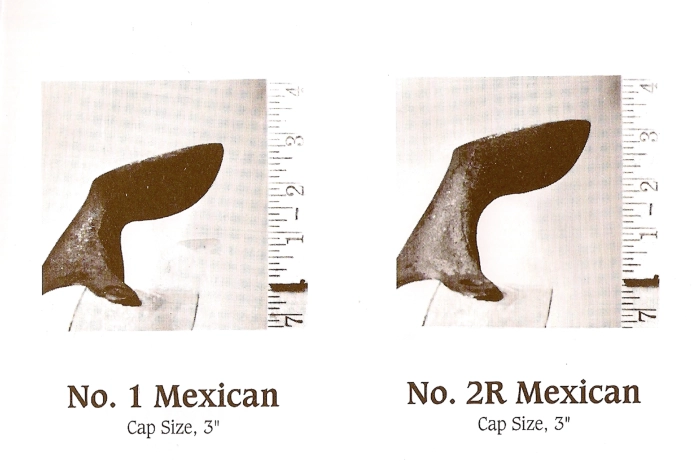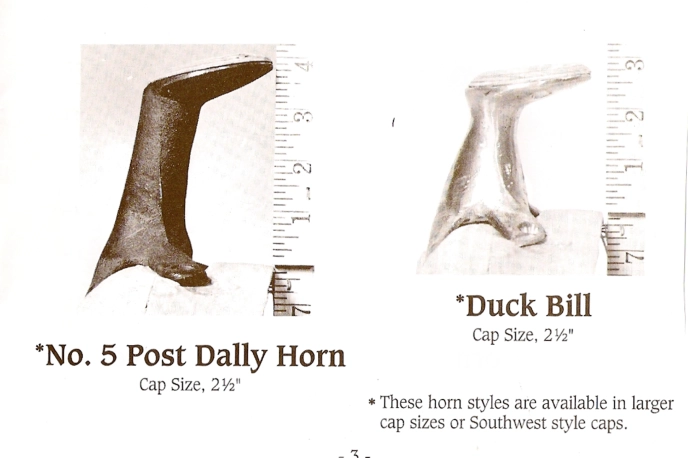Saddle trees have been around as long as saddles have, but surprisingly enough, few newcomers to the business know that much about them. The following information is written for all novices to the art of saddle making as well as for all you pros. If anything has been left out that would be helpful to any others, please let us know.
NOTE: We make custom saddle trees, so we’ll make anything you want. The following is to be used only as a guide.
SEAT LENGTH
The seat lengths of most adult saddle trees today are 15”, 15 1/2”, and 16”. However, we’ll make any length you want.
HORN INFORMATION
In selecting a horn for your tree, please use the following guidelines.
For specific purposes we recommend:
1. Roping – The Dally horns and Post horns are the best.
2. All Around – Whatever you or your customer needs or prefers.
3. Cutting – We recommend the Dally 1 3/4”, stood straight up, because it is easier to grab onto and is what most of our customers prefer.
4. Associations – No horn!
5. Barrel Racers – Most barrel racers want a low, lightweight horn, we recommend the #1, 2 1/2” horn cap
6. Equitation – Equitation riders need a horn that is low so it doesn’t get in the way. The Mexican 3” horn is regularly used for this purpose.
STYLE
Choose from the following: A. Post B. Dally C. Mexican D. Duckbill E. Trick
MEASUREMENT
Use the following picture and illustration to help.
Height Cap Size
Be sure to measure from the top Width of cap: Line AB.
of the horn straight down to the
front of the fork. Line BC
No. 6
Cap size – 2 1/4”
Larger or smaller cap sizes available.
FRONTS
There are so many different styles of fronts on the market today that it’s hard to categorize them all. It seems that every area has it’s certain “favorites” and every saddle maker wants his trees made a certain way. In an effort to simplify things, most saddle trees can be placed in one or more of five different groups.
1. Roping Saddle Trees – Most roping style saddle trees are rounded with a little or no swell. Their main purpose is either to enable a rider to dismount quickly or prevent a thrown rope from getting hung up on the front. An average width is 13” and gullet height is 8”. Some examples of roping trees are S.F. Bowman and Leg Cut Bowman.
2. All-around Saddle Trees – Most saddles used for ranch work and pleasure riding fall into the all-around group. This style has more swell and leg-cut in the front and usually measures either 13” or 14” wide. Usually the gullet height is 8”. Some examples would be either a Little Wonder, Ellensburng, Arizona Roper or Modified Association.
3. Associations – This style of saddle tree was mostly designed for bronc riding. It’s characterized by a large amount of swell in the front and no leg cut. An average width is 14” and the gullet is 9” high. Some examples are the Severe Association and the Shawn Davis Association. Seat sizes on this type tree are generally 15 1/2” – 17 1/2”.
4. Barrel Racers – This style is cut down to lighten the tree for barrel racing. Any style of saddle tree can be cut down to make a barrel racing tree. Some examples are either a Little Wonder Barrel Racer or a MJ Barrel Racer. An average width is either 12” or 13” and the gullet is usually 8” high.
5. Cutting Horse Styles – This style was designed for cutting horse competition. An average width is 13” and the gullet height is usually 8”. Our most popular example is the Dina Special. The most important feature of a good cutting tree is for a seat to be low with the bars thinned down so close contact can be made with the horse.
BARS
We have several different styles of bars available. Some are:
1. Northwest – Used mostly on thicker swells such as Wade, Meana, Wood Post Swells.
2. Hape – Rounded on ends with double stirrup slot. Good all-around bar.
3. Arizona – Recommended for roping and heavy usage. These bars are made with a single stirrup leather groove on the bottom of the bar giving extra strength, but still enable the stirrup leather to fit well.
In addition to fitting a horse well, all of the above bars are usually built up in the front of the seat with a small riser. This small triangle-shaped block gives a more streamlined effect, but can be removed to create a level ride or balanced ride tree.
GULLET WIDTHS AND ANGLES
There are generally three different gullet widths to fit the withers and backs of different size horses.
Semi-quarter Horse – 6 1/4”
Quarter Horse – 6 1/2”
Full Quarter Horse – 6 1/2” or 6 3/4”
CANTLES
There are many different types of cantles being used today, but the more common styles are:
Regular or Oval – The most widely used cantle today. It usually comes 3” or
3 1/2” high.
Comfort – Squared up on the corners with a slight dip in the center. It gives more support for the rider and usually comes 3” high
Shovel – Style used at the turn of the century. It comes with either a straight or beveled edge, is usually 4” – 6” high and no wider than 12”
Round – Simulated shovel style, not quite as pointed
The dish in a cantle will usually vary in size from 1/2” to 2”, usually in 1/4” increments.
COVERINGS
All of our trees are covered with genuine bullhide, the strongest and heaviest available. Before shipping to you, every tree is thoroughly dried and sealed in a special varnish. All bullhide-covered trees have a 5- year unconditional guarantee under normal use.
If you have any additional questions that haven’t been answered by the preceding information, please feel free to write and ask us. We will be more than happy to answer them to the best of our ability. We stress that all trees are custom made to your individual needs and wants, so feel free to ask about anything not listed here. Thank You.

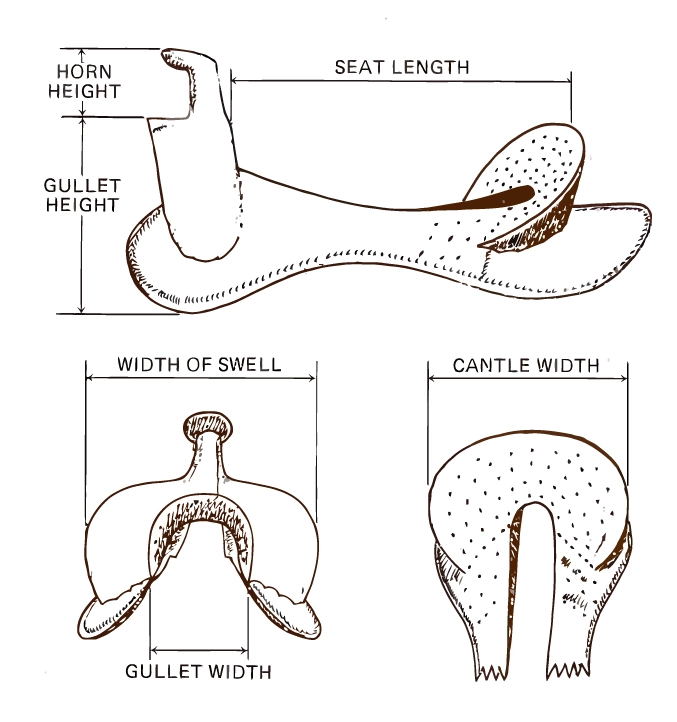
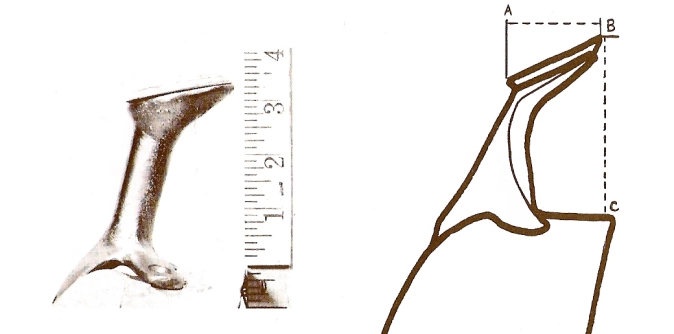
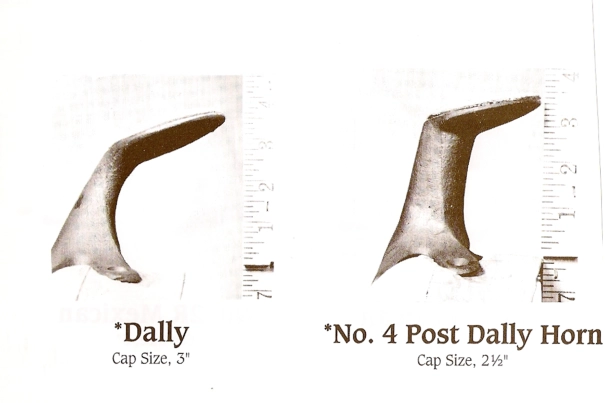
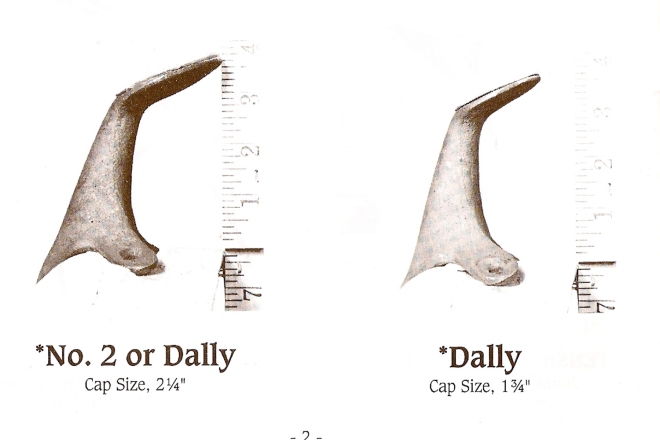
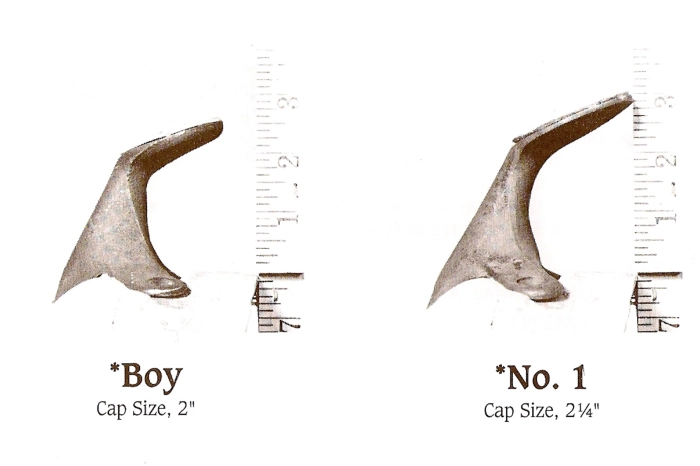 Number 2 Dally and Dally Horn
Number 2 Dally and Dally Horn